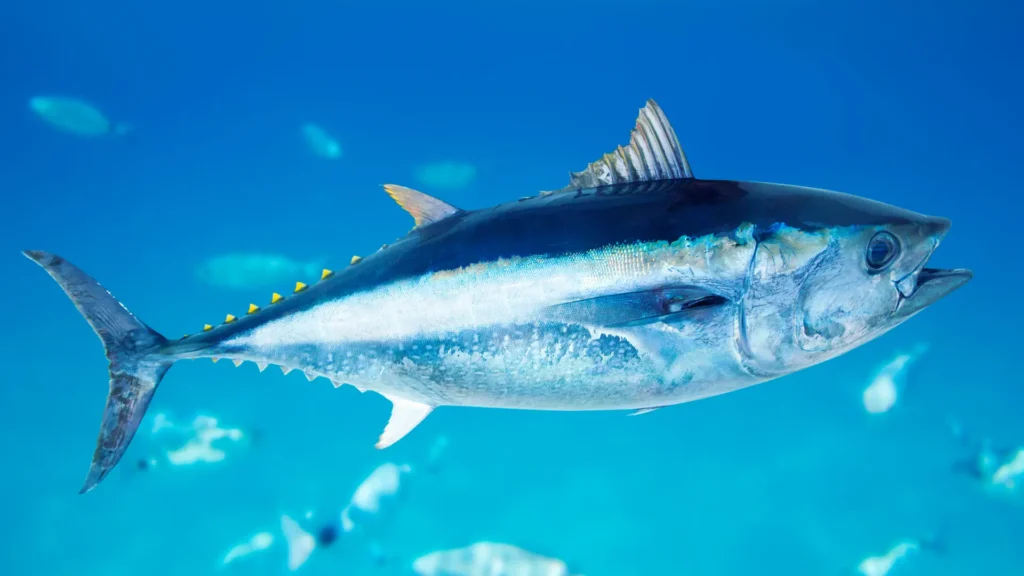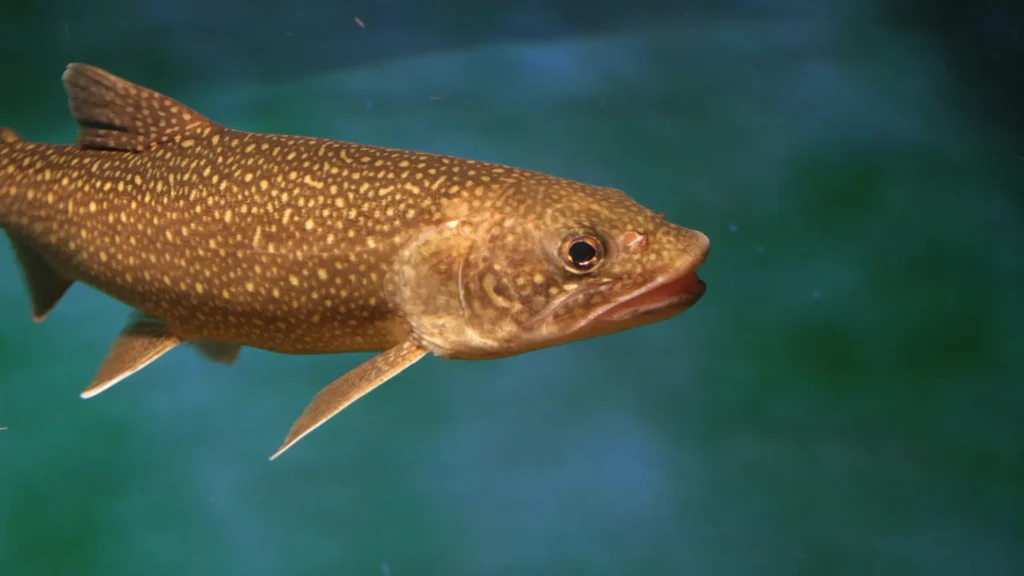Catfish is a popular catch for anglers due to their fight and willingness to bite. They can be found in various freshwater systems across the US, making them accessible to anglers of all skill levels. These sizable creatures can reach impressive weights, with the largest catfish caught weighing 123 pounds.
For successful catfish fishing, a basic rig suffices. But considering their elusive behavior, scouting ideal fishing spots, and being equipped with essential tools is crucial.
In this post, we’ll explore catching catfish comprehensively, offering simple methods and expert tips to enhance your fishing game. If you are ready, let’s start with understanding the different types of catfishes.
Types of Catfish
- Blue catfish – This catfish has a unique mouth structure, with the upper jaw extending slightly beyond the lower jaw. Their barbels also have distinct coloration, with the upper ones dark and the lower ones gray to white. They navigate through water with their squarish anal fin, which has 30 to 36 soft rays. Their forked and rounded tail fin enhances their swimming abilities. Displays a range of colors, from bluish tones to light gray hues. Their relatively small, forward-positioned eyes are an adaptation to their aquatic environment.
- Channel catfish – Catfish have a distinct appearance with an extended upper jaw and grayish-white barbels. Their curved anal fin and forked caudal fin aid in swimming. Their coloration, ranging from olive to dark gray, helps them blend in. This cat also has well-positioned large eyes, enhancing their perception and survival in their aquatic habitats.
- Flathead catfish – The catfish’s unique features include its extended lower jaw and distinctive barbels, which aid in navigation and food detection. Its round anal fin provides stability, while the notched tail fin allows for efficient movement. Catfish display various hues for camouflage. With forward-placed, small eyes, they excel in spotting prey and navigating their surroundings.
- White catfish –It has been a struggle to differentiate between white catfish and channel catfish. Although there are key features that can help with identification. The white catfish has an upper jaw that extends beyond the lower jaw, setting it apart from the channel catfish. Additionally, the white catfish’s anal fin typically displays 22-24 rays. Another distinguishing feature is the presence of a blue ring around the pupil of the white catfish’s eye.
- Black Bullhead Catfish – Black bullheads have captivating coloration. Adult bullheads typically display yellowish-brown or dark green tones, while younger ones exhibit a black hue during spawning. However, relying solely on color for identification can result in misidentification. Instead, pay attention to physical characteristics such as the anal fin. The anal fin of black bullheads consists of 17-21 anal rays, and the caudal fin is rounded with a slight notch. Additionally, black bullheads have an upper jaw that extends further than the lower jaw. Typically measuring around 16 inches, they can reach lengths of up to 24 inches.
- Yellow Bullhead Catfish – The yellow bullhead can be distinguished by its unique features. Unlike other bullheads, its barbels are white. Additionally, its upper jaw extends beyond the lower jaw. Another distinguishing characteristic is the anal fin, which typically has 24-27 rays. The caudal fin appears smooth or slightly rounded without notches or forks. Yellow bullheads can vary in color from yellowish brown to dark brown and can reach up to 17 inches in length.
- Walking Catfish – Catfish, known for their lung-like organs that allow them to breathe air, are a remarkable fish species. The walking catfish, in particular, is highly valued in aquaculture farms and by subsistence anglers. It can stay fresh outside of water and is sought-after in fish markets. This unique feature enables sustainability and convenience for those who depend on this versatile species.
Popular Fishing Techniques for Catfish
Catfishing is an incredibly enjoyable activity that can be pursued in various locations. Once you become familiar with the ins and outs of this fascinating pastime, you’ll be astounded by the number of catfish you can successfully reel in and the impressive sizes they can reach.
Here are some of the fundamental tips on how to increase your chances of hooking different catfishes.
- Rod and reel fishing – As simple as it sounds, this technique uses rod and reel to catch a catfish. Although there are specific kinds of gears and equipment that are only suitable for catfishes. We’ll discuss them further below.
- Noodling/hand fishing – Noodling, or hand fishing, is an exciting way to catch catfish using just your hands. This daring method involves searching for hidden holes in muddy waterbeds where catfish hide. Noodlers reach into these crevices, hoping to encounter a catfish that latches onto their hand. It’s an adrenaline-fueled adventure that demonstrates the resourcefulness and determination of catfish enthusiasts.
- Setline fishing – Set line fishing involves setting out a baited line and allowing it to remain undisturbed. To keep the line in place, weights or anchors are used, allowing it to stay out for hours or days.
The choice of bait is crucial in set line fishing. You can use live bait like worms and minnows or artificial lures that mimic insects or small fish. The bait selection depends on the targeted fish species. Artificial lures are common for bass, while live bait is preferred for catfish. Tailoring the bait to the intended catch improves fishing success.
- Jug fishing – Jug fishing, a popular method for catching catfish, employs floating rigs strategically placed throughout a body of water. These rigs consist of a float, weight, and hook suspended at a specific depth. When it comes to selecting the ideal float for juglines, there are various options worth considering.
Some commonly used items include bleach bottles, detergent bottles, soda bottles, and even pool noodles. These objects serve the purpose of keeping the line and bait afloat while signaling any bites from catfish.
Equipment and Gears for Catfishing
- Rods and reels – Catfishermen use a wide range of rods and reels, from small spinning outfits to long surf-casting rods. For bullheads, an ultralight spinning outfit is ideal. If you target channel cats and encounter 5- to 10-pounders, a 6-foot, medium-action bass-fishing combo works well. To catch large catfish, it’s best to have a heavy-action baitcasting rig made with durable materials. When shopping, consider the available options and invest in the best combination for the conditions and catfish you typically encounter.
- Fishing line – Whether you prefer light or heavy fishing line, catfish aren’t picky. Opt for high-strength, small-diameter monofilaments for versatile and affordable options, ranging from 15 to 25 pounds. However, when targeting larger catfish, consider upgrading to 30-, 40-, or even 80-pound-test lines. In rocky tailraces, rip rapped banks, and dense wood cover, braided lines offer excellent abrasion resistance.
- Fishing hooks – When selecting a hook for catfishing, consider size and style. Smaller hooks penetrate quicker and allow for better bait presentations. Use heavy-gauge designs to ensure they can hold the fish you’re targeting. Match the hook size to the bait, keeping the hook point well exposed. For small catfish, a No. 2 to No. 1 hook is sufficient, while a 1/0 or 2/0 hook works well with thin cut bait strips. For thicker cutbait chunks, use a 3/0 or 4/0 hook. When using live bait fish up to six inches, opt for a 5/0 or 6/0 hook. For larger baits, switch to even bigger hooks.
Catfish anglers favor the circle hook style to ensure a quick and effective hookset. These hooks are specifically designed to penetrate the catfish’s mouth, usually in the corner, which maximizes hook retention during the fight. This reduces the risk of deep, ineffective hooksets in bony areas. As a result, catfish can be safely released after the battle, minimizing any potential harm.
- Sinkers – When fishing for catfish, using sinkers is crucial for getting your bait to the right water level. The best sinker choice depends on factors like rig type, water depth, current speed, and bottom condition. Optimize your setup by selecting a sinker size that keeps your bait steady at the desired water column level, improving your chances of success.
- Bobbers and floats – Bobbers, also known as floats, make casting small baits easier and more efficient for catfish fishing. By adding weight, they ensure that your bait reaches the areas where catfish are commonly found. The bobber’s distinct path allows you to track the movement of your bait and increases your chances of avoiding snags.
Additionally, it provides a clear indication when a fish bites, enabling immediate response. Furthermore, bobbers allow you to suspend your bait just above the bottom, where catfish frequently feed.
- Swivels – Many anglers add swivels to their catfishing rigs to prevent twisting and rolling. It is advisable to invest in high-quality ball-bearing swivels instead of cheap brass-plated ones to increase the chances of landing a trophy catfish.
Best Times and Locations for Different Techniques
Catfish exhibit adaptability to varying water systems, thriving in environments ranging from warm ponds to fast rivers. While different species may prefer different habitats, there are specific locations where catfish tend to congregate.
During the day, muddy water areas such as tributaries and their outflows are prime spots to find catfish. Additionally, deep structures like river bends, the base of drop-offs, deep holes, and humps are favored locations. Catfish seek refuge around cover, such as standing timber and deep weed edges.
Nighttime fishing offers excellent opportunities as well. Catfish rely on their enhanced senses of smell and taste, along with their barbels (whiskers), to forage for food in the darkness. Flats, bars, points, shorelines, and weedy areas are frequented by prowling catfish during the night.
Conclusion
In conclusion, mastering the art of catfish fishing requires a combination of skill, patience, and knowledge. By employing professional tips such as selecting the right bait, understanding catfish behavior, and choosing the appropriate gear, anglers can enhance their success on the water.
If you have more ideas on how to catch a catfish, let us know in the comments below!
Additional Resources:
- How To Catch Catfish: Basics – https://www.takemefishing.org/how-to-fish/how-to-catch-fish/how-to-catch-catfish/
- Guide to Catfish Fishing – https://www.purefishing.com/shakespeare-ome-beginners-guide-to-catfish-fishing
- How to Catch Catfish: the Complete Catfishing Guide – https://fishingbooker.com/blog/how-to-catch-catfish-complete-guide-to-catfishing/


